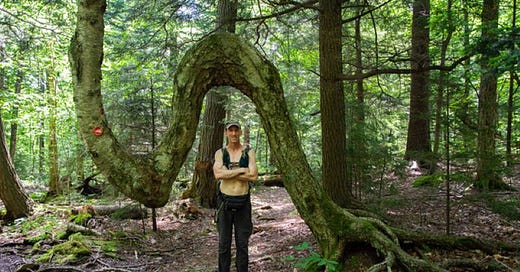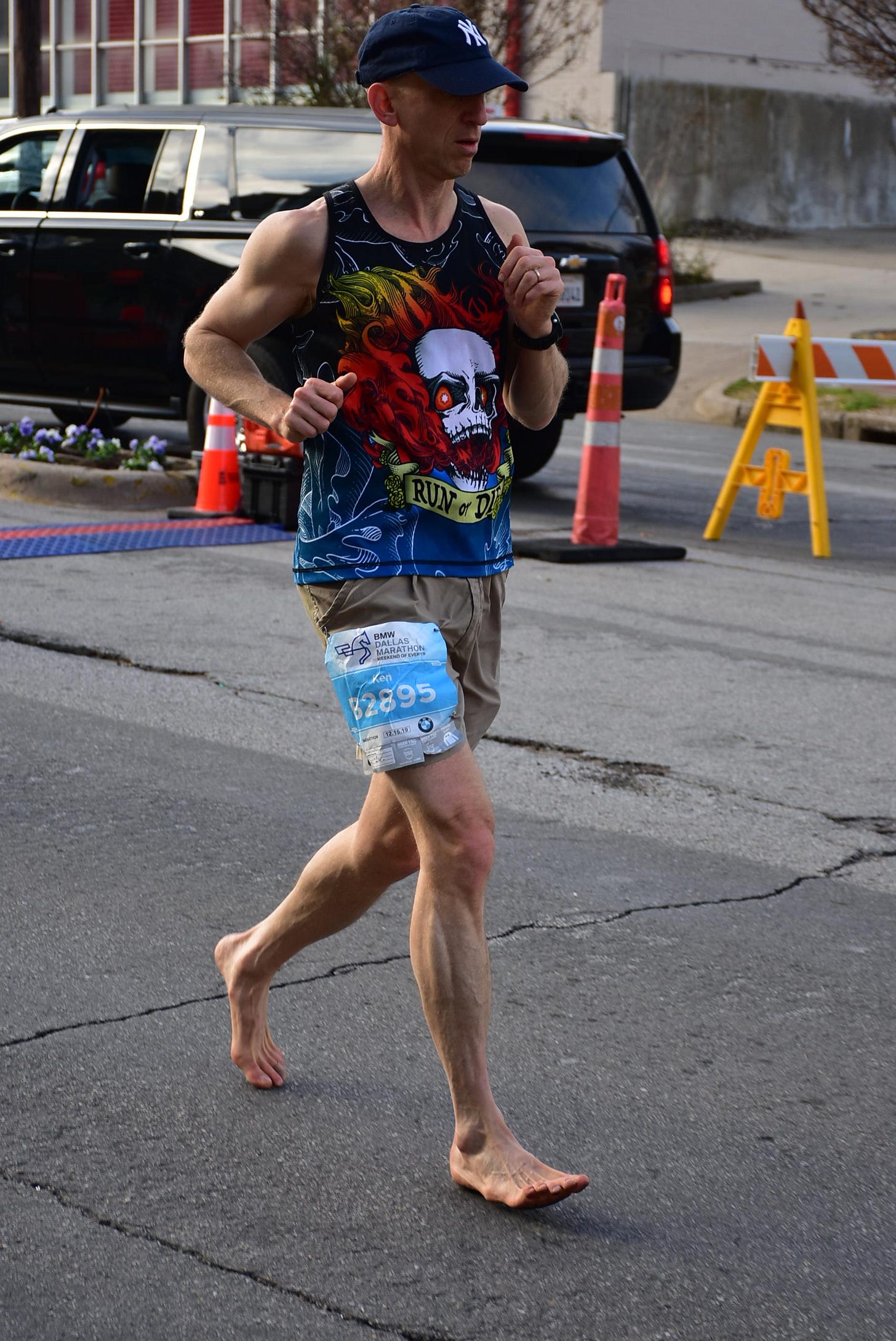Ken Posner: The minimalist runner who embodies the barefoot spirit
The race director of the Shawangunk Ridge Trail Run says shunning trainers improved his running experience
I was once told the best journalists don’t mind asking stupid questions, and as I talk to self-proclaimed minimalist and barefoot runner, Ken Posner, I realise I need to test the theory out.
Taking a deep breath, I summon up my inner David Frost and ask: “But don’t your hurt feet when you step on a stone?”
Eat your heart out Jeremy Paxman.
Ken, a man who has completed 102 marathons and ultra-marathons, laughs: “That’s part of it.”
Like many other minimalist runners, he started running barefoot after reading Chris McDougall’s seminal book ‘Born to Run’.
Ken was keen to see how running barefoot could improve his natural form and make him more resilient to injuries.
“Then I thought, I’m getting a bit old and barefoot might be a bit slower, but at this stage of my career that might be ok,” he says.
“I’m getting to that point where I’ve set all my lifetime PRs.
“The surprise was that it was more fun.”
I want to pause here to briefly talk about what ‘slowing down’ means for Ken Posner - because we’re not talking about no longer being able to do a 29 minute parkrun.
As recently as 2014, he completed the Badwater Double, a 292-mile ultra through Death Valley, in what was a then-record 90 hours 39 minutes.
“I think I still hold it,” he adds.
The Badwater Double is a rarely run route taken on by those who decide the 135-mile Badwater Ultramarathon - dubbed ‘the world's toughest foot race’ - just isn’t quite far enough.
The original Badwater ran for 146 miles from the Badwater Basin in Death Valley to the summit of Mount Whitney. Those who take on the Double stick to that original course - before running back.
A handful over 30 people have completed the run.
In typically modest terms, Ken tells me: “It gets quite warm in Death Valley - it was 127 degrees when I was there, with headwinds.”
So, yeah, slowing down is a relevant thing, but Ken was ready to do so - and to ditch trainers.
“I really have no interest in running in shoes anymore” he tells me.
“They are great technology, but they take away the intensity. They make you start to run heavy, it’s like clumping, you are just waiting for the miles to go.
“Barefoot is super intense, but you also have this wonderful feeling of light-footedness.”
Ken tells me the way to start running barefoot is by being slow and careful - find a “soft spot” to get used to the feeling of running without shoes.
“But then,” he says, “you want to train on rougher ground, because that is what will teach your body the skill of stepping lightly, which is totally lost in shoes.
“Pick a one mile loop with dirt and some gravel. The first time I did that I was mostly tip-toeing between the stones, but after six months or a year I was running as fast as I could.”
Tackling the Shawangunk Ridge Trail Run
“It has a so-called unsupported format. We have checkpoints, we take safety very seriously. We have never lost anybody, but we don’t provide any aid.”
Ken Posner is talking about the Shawangunk Ridge Trail Run or SRT for short - an event he founded and is the race director of.
Taking place every year in September - the year’s run is on the 8th and 9th - the SRT is “a little bit different from your typical trail race”.
It comes with three distances - a half-marathon, 30-miler and the event’s showpiece 70-mile race.
The first two of those races come with what Ken calls “generous time limits” with almost everyone completing them.
The 70-miler is not so kind to competitors, with around half of entrants finishing.
Ken says: “They are all point-to-point on top of this gorgeous ridge in the Hudson Valley, spectacular 100 mile views and very, very rare ecosystems, waterfalls and shiny white cliffs.
“You’ve got to bring your own food, you’ve got to bring a water filter to get water from the streams.
“We don’t mark the course. We give people an app on their phone so they follow where they are going.
“It is not an orienteering course, but you have got to pay attention.”
Ken was the first person to run the 70-mile SRT, back in 2014. While it took him just under 24 hours to finish, he says today’s winners will complete the course in around 16 hours.
“I had so much fun, it was such a special experience that I created the race with a friend, Todd Jennings, in 2015.
“We attract a wide-range of folks, from elites to people who are just getting into running. The participants embody the spirit of self-reliance.
“That is what we are trying to promote.”
One thing he says stands out about the SRT is that the “little bit of extra mindfulness” it requires means the fastest person doesn’t always win it.
“It’s the person who’s fast and can keep their act together as they supply themselves with food and water, and just makes sure they stay focused on where they are as they make their way through the forest,” he explains.
“There is nothing wrong with a conventional race, which is marked and has wonderful food and aid stations.
“That’s all great, but this is a race that promotes self-reliance and the ability to manage yourself along the course.”
‘Happy feet’
Ken tells me that, with training, our feet “are smart”.
“If you think about our ancestors - hunters and gatherers in the forest, for the most part they didn’t have shoes.
“My mum told me that my great-grandmother went around barefooted in the old country because she was an orphan. Nobody was going to buy her shoes.
“Feet are mission critical equipment. You are not going to want to hurt your feet, but what that means is you are going to pay attention to where you step.
“Part of the fun of barefoot is the original human mindfulness. You are 100% alert and you are paying attention to everything, and stumbling and putting your foot anywhere is just not acceptable.
“What will happen is that you will go very slowly on difficult terrain, and very carefully.”
As a minimalist runner, it is not only shoes which Ken regularly does without: “There are a lot of ways to be minimalist.
“People think about it as living more simply - say in a smaller house, without as many luxury goods.”
He says it is about finding “that original primal self, which had a lot of strength”.
When it comes to running that includes going shirtless in the winter, training in the cold or extreme heat and rarely carrying food or water - all Ken’s personal best times up to the marathon distance were done without taking anything on.
“It can mean navigating through the forest without using a map or compass, it can mean prowling around at night without lights.
“It’s ways just to tap into your original human capabilities because that helps you understand who you are and what you are capable of.
“I feel the risk in the modern world is that we have so much technology that you end up in this place where you are coddled. I don’t know if that is a great strategy.”
It is a philosophy which Ken believes can be beneficial when it comes to every day life.
“I’ve long thought of running as a form of training,” he says.
“The first marathon I ran, I felt this will make me a better person. Running and other disciplines are a great training just to get that self-control. That ability to manage yourself through stressful situations.
“With running you have the physical discomfort and the anxiety. Then you go to work and your boss yells at you or whatever, and you are like, you know what, I can deal with this.”
For Ken, many modern races are very one-dimensional: “It’s all about speed over a distance, and it’s on a road where all the obstacles have been cleared, and it is driven by clocks and it is very egotistical in that people are competing to win.
“And that’s all fine, I love conventional races but there are a thousand different directions you can go.
“You can go from road running to trail running, or obstacle course running. From running to hiking in the forest.
“With respect to barefoot, because there is a transition, it is hard for people to do.
“You have to be a bit of a free spirit, you have to be willing to do something different.”







